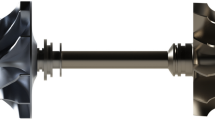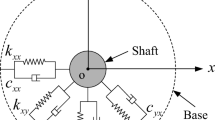Abstract
The need of rotating machines to operate at higher speeds requires better techniques of vibration control. This paper presents how optimal control is applied to rotor-bearing-support systems in which the rotor finite element models have relatively large degrees of freedom (DOF). To conduct the control design for such rotor finite element models with large DOF is challenging and expensive. At this point, the order reduction of the model has its role. In this work, two types of rotor-bearing-support system were used: one with tilting pad journal bearings and the other one with plain full journal bearings which is typically less stable. For cost consideration, the large DOF rotor was reduced into smaller DOF. The quality of the model reduction was evaluated by comparing some first natural frequencies, modal damping ratios, critical speeds, and response of both the full system and the reduced system, along the frequency range of interest. To control vibration, linear quadratic regulator (LQR) control technique was used. From the closed-loop responses, it is shown that the LQR controller suppresses the resonance quite well. In this case, two different pairs of weighting matrices were used. It is shown that the first pair is better at lower speeds, whereas the second pair is better at higher speeds.
















Similar content being viewed by others
References
Wagner MB, Younan A, Allaire P, Cogill R (2010) Model reduction methods for rotor dynamic analysis: a survey and review. Int J Rotating Mach 2010:1–17
Guyan J (1965) Reduction of stiffness and mass matrices. Am Inst Aeronaut Astronaut J 3:380–386
Zhang D (1996) An improved Guyan reduction and successive reduction procedure of dynamic model. Chin J Comput Struct Mech Appl 13(1):90–94
Kidder RL (1973) Reduction of structure frequency equations. Am Inst Aeronaut Astronaut J 11(6):892
Miller CA (1980) Dynamic reduction of structural models. ASCE J Struct Div 106(10):2097–2108
Paz M (1984) Dynamic condensation. Am Inst Aeronaut Astronaut J 22:724–727
Sotiropoulos GH (1984) Dynamic reduction algorithms for the structural eigen problem. Acta Mech 50:231–248
Zhang N (1995) Dynamic condensation of mass and stiffness matrices. J Sound Vib 188(4):601–615
Khulief YA, Mohiuddin MA (1997) On the dynamic analysis of rotors using modal reduction. Finite Elem Anal Des 26:41–55
Varga A (1994) On modal techniques for model reduction, in 1st MATHMOD conference, Wien, 1994
Varga A (1995) Enhanced modal approach for model reduction. Math Model Syst 1:91–105
Craig RR, Bampton MC (1968) Coupling of substructures for dynamic analysis. Am Inst Aeronaut Astronaut J 6(7):1313–1319
Hurty WC (1960) Vibration of structural system by component mode synthesis. Proc Am Soc Civil Eng 85:51–69
Neal RHM (1971) A hybrid method of component mode synthesis. Comput Struct 1(4):581–601
Shu C-F, Chu F-H (1984) General superelement approach by the component mode synthesis method. In: The 2nd international modal analysis conference and exhibit (Orlando, FL). Union College, Schenectady, NY, pp 676–682
Blomeling F (2006) Substructuring and SVD-based model reduction. Proc Appl Math Mech 6(1):709–710
Ohayon R, Sampaio R, Soize C (1997) Dynamic substructuring of damped structures using singular value decomposition. J Appl Mech Trans ASME 64(2):292–298
Reis T, Stykel T (2008) Balanced truncation model reduction of second order systems. Math Comput Model Dyn Syst 14(5):391–406
Houlston PR, Garvey SD, Popov AA (2007) Modal control of vibration in rotating machines and other generally damped systems. J Sound Vib 302(1–2):104–116
O’Callahan J, Avitabile P, Riemer R (1989) System equivalent reduction expansion process (SEREP). In: The seventh international modal analysis conference, Las Vegas
Papadopoulos M, Garcia E (1996) Improvement in model reduction schemes using the system equivalent reduction expansion process. Am Inst Aeronaut Astronaut J 34(10):2217–2219
Qu ZQ, Fu ZF (1998) Comment on improvement in model reduction schemes using the system equivalent reduction expansion process. Am Inst Aeronaut Astronaut J 36(10):1941
Das S, Dutt JK (2012) A reduced rotor model using modified SEREP approach for vibration control of rotors. Mech Syst Signal Process 26:167–180
Marscher WD (2007) An end user’s guide to centrifugal pump rotordynamics. In: Proceedings of the twenty-third international pump users symposium
Fan GW, Nelson HD, Crouch PE, Mignolet MP (1993) LQR-based least-squares output feedback control of rotor vibrations using the complex mode and balanced realization methods. J Eng Gas Turbines Power 115(2):314–323
Abduljabbar ZS, ElMadany MM, Abdulwahab AA (1996) Active vibration control of a flexible rotor. Comput Struct 58:499–511
Abduljabbar ZS, ElMadany MM, Al-Bahkali E (1997) On the vibration and control of a flexible rotor mounted on fluid film bearings. Comput Struct 65(6):849–856
ElMadany MM, Abduljabbar ZS (2000) Controller design for high-performance turbomachines. J Vib Control 6:1205–1223
Kim S, Lee CW (1996) Isotropic optimal control of active magnetic bearing system. ASME J Dyn Syst Meas Control 118:721–726
Arias-Montiel M, Silva-Navarro G (2010) Active unbalance control in an asymmetrical rotor system using a suspension with linear actuators. In: Proceedings of SPIE 7643, active and passive smart structures and integrated systems 2010, 76432 W, 12 April 2010
Wen XL, Song CS, Cao C, Ding GP (2012) Study of the LQR controller for magnetic flywheel rotor system. Appl Mech Mater 150:221
Houlston PR (2007) Active vibration control of rotating machines. PhD Thesis, The University of Nottingham
Schittenhelm RS, Wang Z, Riemann B, Rinderknecht S (2013). State feedback in the context of a gyroscopic rotor using a disturbance observer. Eng Lett 21:1
Cook RD (1995) Finite element modeling for stress analysis. Wiley, USA
Jones S (2005) Finite elements for the analysis of rotor-dynamic systems that includes gyroscopic effects. PhD Thesis, Brunel University School of Engineering and Design
Logan L (2007) A first course in the finite element method, 4th edn. Thomson, India
Pilkey WD (2008) Geometric properties of planes, in formulas for stress, strain, and structural matrices. Wiley, NJ
Lund JW (1987) Review of the concept of dynamic coefficients for fluid film journal bearings. J Tribol 109(1):37–41
Khonsari MM, Booser ER (2001) Applied tribology: bearing design and lubrication. Wiley, NJ
Childs D (1993) Turbomachinery rotordynamics: phenomena, modeling, analysis. Wiley, NJ
Va´zquez JA, Barrett LE, Flack RD (2002) Flexible bearing supports, using experimental data. ASME J Eng Gas Turbines Power 124:369–374
Caruso WJ, Gaus BE, Catlow WG, Application of recent rotor dynamics developments to mechanical drive turbines. In: Proceedings of the 11th annual turbomachinery symposium, Texas A&M University, College Station, TX, December 1982, pp 1–17
Bethel LL, Gans BE, Brown RN, Lewis RA Critical speeds and the importance of stiffness—a case study in the design and testing of a large mechanical drive steam turbine to api standard 612. In: Proceedings of the twenty-second turbomachinery symposium
Acknowledgments
The authors extend their appreciation to the Deanship of Scientific Research and the Research Center of the College of Engineering at King Saud University for funding this work.
Author information
Authors and Affiliations
Corresponding author
Additional information
Technical Editor: Fernando Alves Rochinha.
Rights and permissions
About this article
Cite this article
Rosyid, A., ElMadany, M. & Alata, M. Optimal control of reduced-order finite element models of rotor-bearing-support systems. J Braz. Soc. Mech. Sci. Eng. 37, 1485–1497 (2015). https://doi.org/10.1007/s40430-014-0292-2
Received:
Accepted:
Published:
Issue Date:
DOI: https://doi.org/10.1007/s40430-014-0292-2




